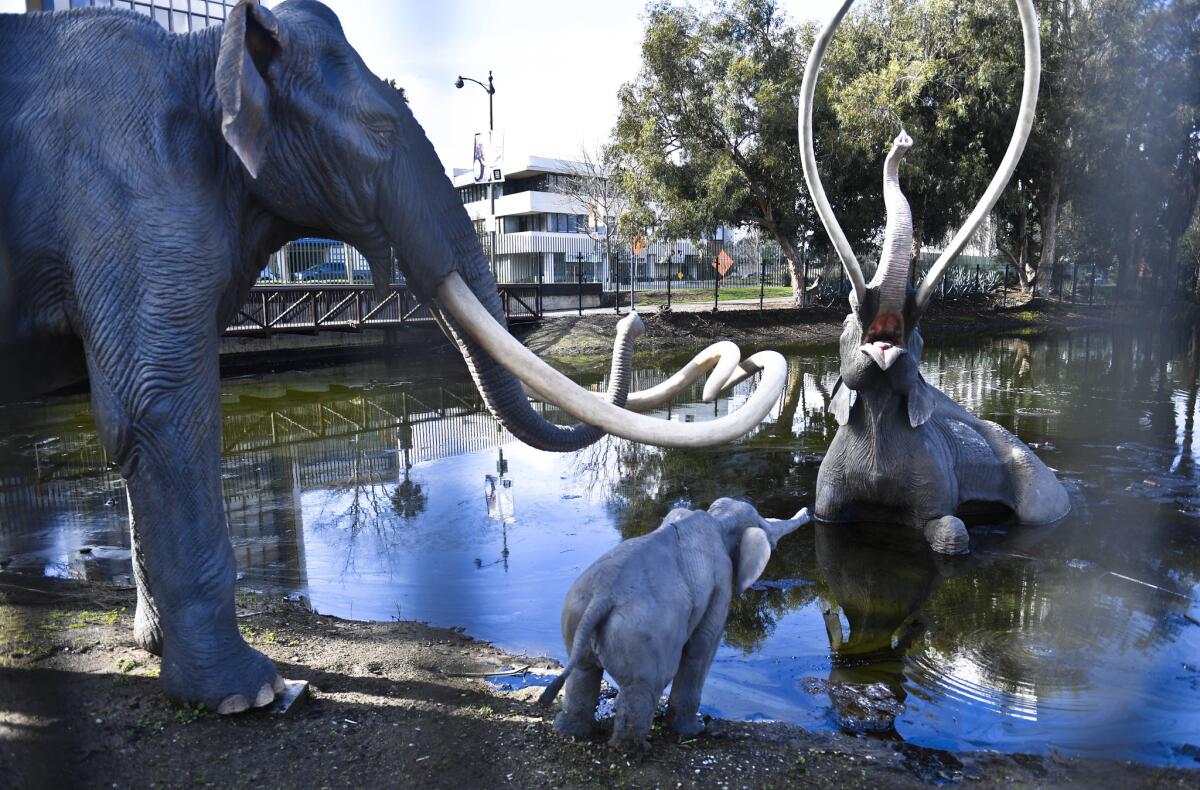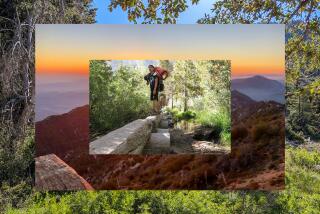Mammoth memories: L.A. loves the La Brea Tar Pits’ potentially displaced creatures

- Share via
The La Brea Tar Pits, the museum, park and paleontology research location in Los Angeles, faces a looming makeover that could reshape its legacy.
On Monday, the museum announced three potential designs submitted by architecture firms for the park’s renovation. One keeps the more than 40-year-old George C. Page Museum largely untouched. Another lifts the museum’s entrance for better visibility but maintains its footprint, adding a more transparent story on top. And the last plan rebuilds the museum completely and considers relocating indoors the statues of a beloved mammoth family that have inhabited the tar pits for 50 years.
The first fiberglass mammoth was driven to the tar pits in 1967 on a trailer pulled by sculptor Howard Ball’s 1958 Volkswagen. Its baby and female companion soon followed.
What will become of the tar-trapped 13-foot-high, 25-foot-long fiberglass mammoth that has guarded its family and a bustling Wilshire Boulevard for five decades, you ask? The trio’s future is unknown. But whatever happens, the mammoths have left everlasting memories in the hearts of Angelenos and tourists alike.
Change is coming to Los Angeles’ La Brea Tar Pits and possibly its beloved, tar-trapped mammoth. Three acclaimed architecture firms unveiled proposals to remake the site.
We asked readers to share their favorite memories of the La Brea Tar Pits’ Columbian mammoths. Here’s a taste of what you told us.
Simone Wicks
“I have grown up across the street from the tar pits my entire life; my parents still live there. We took walks at the park every day as kids. I’ve always felt for the sad dying daddy elephant and crying baby elephant. So tragic. But I loved it! So much emotion in such a smelly place.”
John Young
“I came to California in 1977, and the mammoth at the La Brea Tar Pits is one of the first things I saw. Whenever people come to visit for the first time and I take them to the tar pits, they always comment on how excited they were by the mammoth and little ones. Please keep the mammoth!”
Doug Short
“This is the most striking image from all the annual field trips I took as a kid. It was simply tragic and fascinating and no other exhibit could convey so much story as this tableau. It is idiotic to consider moving it and only someone who has little regard to what makes this city Los Angeles would propose removing it. The fundamental lack of understanding should disqualify this team’s entry immediately.”
The famous fiberglass mammoths at the La Brea tar pits have kept watch over Wilshire Boulevard for five decades.
Dan Pecchenino
“My 3-year-old son, wife and I walk through the park and by the mammoths at least once a week. Since he could talk, my son has said, ‘I want to see the elephants, Daddy.’ We always go look at them and talk about the mammoths and other animals that used to be in our backyard. In these moments, he usually manages to turn the conversation toward the prospect of getting dinner at the Counter. Sometimes it works. But it never gets old.”
Sal Valdez
“My two sons are in their 30s now, but when they were little boys I took them to the tar pits. Like many children, they were mesmerized by the creatures stuck in that lake. Now as adults, they love taking their own kids there, so it has been a multigenerational love affair.”
Alice Bickers
“Taking my daughter there when she was little, 2-4. While the museum was pretty over her head then, she always instantly recognized the mammoths and knew where we were.”
Leobardo Cabeza
“The first time I saw the mammoth and his family was like if I was living back in this era and it was very magical and educational.”
Maria
“I mean, it’s kind of horrible, isn’t it? The baby is sad one of its parents is being sucked into a black lake of tar. I used to work in the area, and I have reenacted the scene myself while walking back from lunch. Never got my big acting break, though.”
Mary Hampton
“My mom insisted our workaholic dad spend Sundays with my brother and I. Sometimes we were dropped off at a movie double-feature, but SOMETIMES he took us to different L.A. Museums. The tar pits and Page Museum were our favorite! We spent hours wandering around & being immersed in the lore of the mammoths. As a college student, I volunteered at the museum. Later, as a teacher, I created an entire dinosaur unit and took many groups of kids on field trips to this fascinating place. I live in New Mexico now, but I can still think of the tar pits, ‘see’ the mammoth stuck in the tar with his baby crying on shore, and I swear I can ‘smell’ the tar that told such a powerful story!”
From the story’s comments section:
@Brianincalifornia
“As a 7-year-old when I visited the place back in the ’80s, the Mammoth sculptures connected me to the past in an emotional way, just by visually seeing the scene without any explanation or signs. Not that I cried or anything, but you kind of take in the scene and start wondering what caused the tar, why the animals went there ... You kind of got how it was an important place even before you understood the science and history behind it. I think the mammoth scene in the tar pit is important to captivate the younger kids no matter which version they use.”
@J_Torres
“I remember rolling down those berms as a schoolkid back in the ’70s, and my own children did the same. They were mesmerized by the mammoth in the tar pits. My then-4-year-old son couldn’t stop talking about that hokey mechanical bison after his first visit. Revamp if you will, but you cannot move those mammoths. It’s a rare bit of Los Angeles that multiple generations have enjoyed.”
More to Read
The biggest entertainment stories
Get our big stories about Hollywood, film, television, music, arts, culture and more right in your inbox as soon as they publish.
You may occasionally receive promotional content from the Los Angeles Times.











